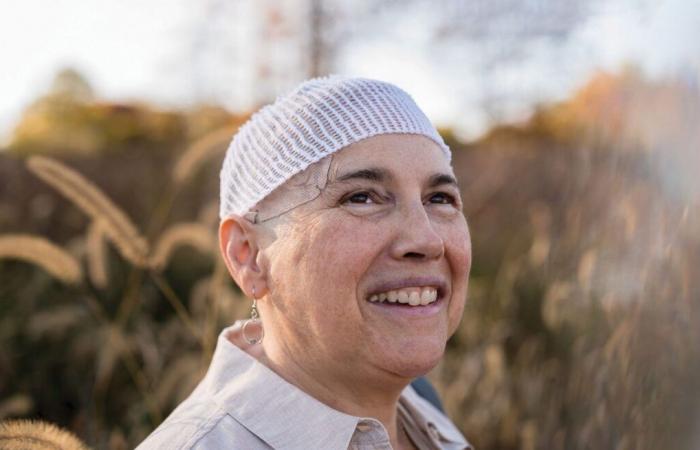Partner content
For several years, the Dr David Roberge is tirelessly fighting for the Ministry of Health to fund the magnetic field helmet, a revolutionary treatment that significantly increases the quality and life expectancy of people with glioblastoma. An innovative therapy, which has demonstrated its effectiveness in slowing the progression of this particularly aggressive form of brain cancer. Interview.
In 2022, Health Canada approved an electric field therapy for brain cancer that can be used in addition to chemotherapy and radiotherapy treatments. The Optune helmet, equipped with 36 electrodes, emits electric fields aimed at slowing or stopping the cell division of malignant tumors; it is powered by a generator that can be carried in a small backpack. For optimal results, it must be worn by the patient more than 18 hours a day, 7 days a week, for 2 years.
The Dr David Roberge, researcher and investigator in oncology and radio-oncology at the CHUM, who has been treating patients with this device since 2013 as part of clinical studies, is well placed to confirm that the treatment, which makes it possible to reduce the size of tumors of meaningful and minimally invasive way, has the power to transform patients’ lives. “Each case of glioblastoma is of course unique and distinct, but, while the life expectancy of patients is estimated at 5% after 5 years, it rises to 13% for the same period with the use of magnetic field helmets. The chances of survival will therefore more than double. »
Looking for funding
The problem: despite its proven effectiveness, the Optune headset is not reimbursed by the RAMQ. Indeed, the National Institute of Excellence in Health and Social Services (INESSS) considers that its beneficial effects do not justify the proposed price, which is high, as is very often the case for anticancer therapies. “In reality, the price can always be negotiated, and that is precisely what I am asking of the Ministry of Health,” explains the radiation oncologist. The problem is that the evaluation process took place, but we did not go to negotiation. I understand that the Department of Health’s resources are not infinite, but due to the relative rarity of the disease, the impact on its budget would be negligible. »
The factor that complicates the situation, according to him, is that the approval protocol for this therapy does not follow the same course as that of a drug. “The helmet is not a product that we buy, but rather a service, which means that it does not fit into the usual boxes. At the same time, INESSS considers that patients who live alone need help to manage the installation of the helmet and the changing of the electrodes, which must be done on a regular basis, while they can use the services of the CLSC. In fact, the therapy does not require additional resources, tests or hospitalization, and causes minimal side effects. Patients can even attend school or go to work while wearing the helmet. »
What the D deploresr Roberge has been losing all the time since 2013. “There are new therapies for breast cancer, prostate cancer or colorectal cancer every year. This is normal due to their incidence. The same is not true for glioblastoma, which is a rarer disease, but which still affects 3.4 Canadians out of 100,000. However, in 20 years, despite all the efforts that have been made in research, there has been no better treatment for the disease than the magnetic field helmet. We found a treatment that works and ten years later, the therapy is still not available in Quebec or Canada, while it is in France, Germany, Sweden, Switzerland, Austria, Israel and Japan. It’s frustrating to feel that I am not supported by our health system to improve the fate of people who suffer from glioblastoma. »
Access for all patients, a priority
In the meantime, for years, the radiation oncologist has been negotiating directly with the manufacturer and various organizations to allow his patients – more than a hundred to date – to benefit from the effects of the Optune headset. Thanks to his efforts, many benefit from compassionate treatment provided by the manufacturer, while others receive it for free by participating in research projects or, more rarely, through private insurance. And even though the treatment is only approved for adults, it also treats children.
Because the other workhorse of the Dr Roberge is to obtain access to magnetic field headphones for those under 18 years old. “Clinical studies were conducted in adults, in adult hospitals, and high quality data is not available for minors. Whereas, biologically, if there is a good difference between a one-year-old child and an adult, there is very little difference between a 15 or 16-year-old teenager and a young adult. »
One thing is certain according to him: access to this cutting-edge treatment must be expanded and offered free of charge to all patients with glioblastoma. “Right now, it’s often the people who have the most resources or who are best able to find out information who end up hearing about me and contacting me directly, if not through their treating physician. This is not a democratic process! »
We found a treatment that works and ten years later, the therapy is still not available in Quebec or Canada, while it is in France, Germany, Sweden, Switzerland, Austria, Israel and Japan. It’s frustrating to feel that I am not supported by our health system to improve the fate of people who suffer from glioblastoma.
Time is running out
The hours spent juggling regulations, navigating bureaucracy, filling out mountains of forms and dealing with different organizations did nothing to temper the radiation oncologist’s determination. And that’s without counting all the media hype he created with his patients to highlight the problem to the general public and decision-makers. A last resort approach which has given concrete results by allowing adults and young people alike to have access to treatment, but which demonstrates the flaws of the health system in the face of such a glaring problem.
But the Dr Roberge does not give up. He is, more than ever, ready to fight to assert the rights of people affected by glioblastoma and insists that time is running out. “If the therapy is only approved in 2026, the patient who is sick now risks dying in the meantime, even though this death could be avoided. The ball is in the court of the Ministry of Health. »
To find out more!
The Federation of Specialist Physicians of Quebec (FMSQ) defends and supports the approximately 11,000 doctors working in one of the 59 medical specialties recognized in Quebec. The FMSQ also promotes the provision of high-quality care and services for the Quebec population.
This content was produced by the Special Publications team at Duty in collaboration with the advertiser. The editorial team of Duty had no role in the production of this content.
To find out more about the Federation of Specialist Physicians of Quebec






